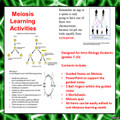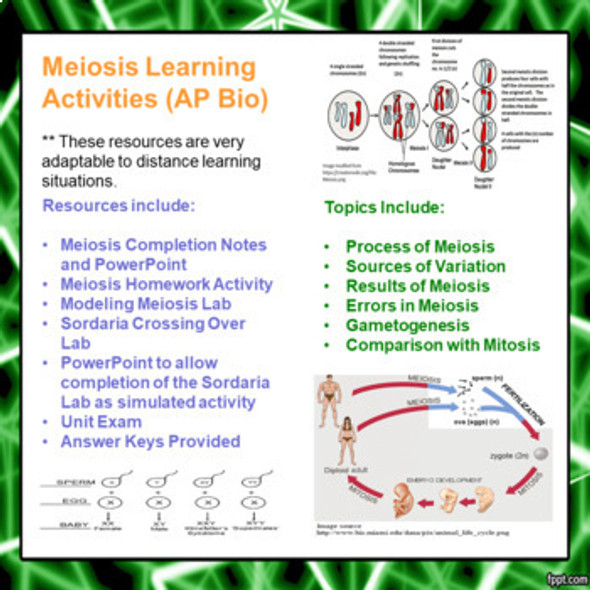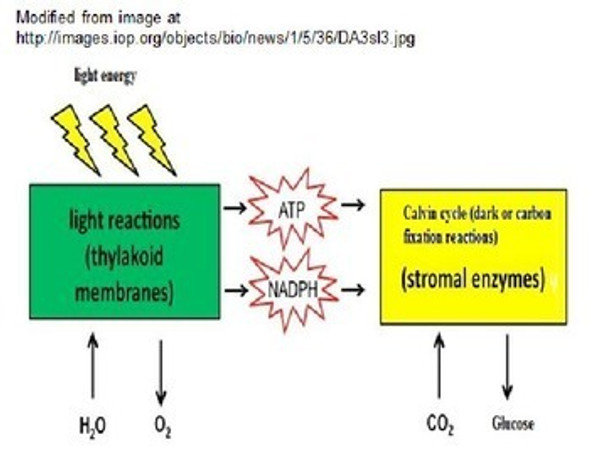Description
This is a series of lesson activities for a unit on the topic of Meiosis for introductory biology students. The learning goals been correlated to the performance indicators of the NY Living Environment core curriculum, Next Generation Science Standards and the Common Core Learning Standards.
All pdf files are also available in editable word format to allow you to make changes to these files to best suit your course and your students. These documents are well suited for use in distance learning environments.
These activities Introducing Meiosis are in a zip file (containing 12 individual files and 28 pages on student handouts/49 pages with answer keys) which includes the following components:
- A 7 page cloze completion notes handout for students including unit learning goals
- 51 slide PowerPoint to accompany the notes handout for the students
- 5 bell ringers/closures with answers included in PowerPoint
- Marzano student self assessment handout for unit
- Meiosis Worksheet One with key
- Meiosis Worksheet Two with key
- Meiosis quiz with key
- Meiosis practice quiz with answers for students
- Curriculum Correlations to the NGSS, Common Core and NY Living Environment Core Curriculum
Meiosis Learning Goals
Upon completion of this unit the student will be able to:
1. define the term gametogenesis.
2. recognize that chromosomes exist in pairs in body cells.
3. recognize that each species has a characteristic number of chromosomes.
4. define the following terms correctly; homologous chromosomes, diploid number, haploid (monoploid) number, gametes, and gonads.
5. explain how the chromosome numbers are halved in cells produced by meiosis.
6. recognize that meiosis only occurs in animals in gamete producing cells of the gonads.
7. explain how the species diploid number is maintained through meiosis and fertilization.
8. describe the first meiotic division and explain the following terms; tetrad and crossing over.
9. briefly describe the second meiotic division.
10. explain why cells formed as the result of meiosis show variation from each other and their parent cell.
11. correctly define the terms disjunction and nondisjunction.
12. explain how nondisjunction may result in Down's Syndrome or polyploidy.
13. compare and contrast the processes of spermatogenesis and oogenesis.
NGSS Standards
Students who demonstrate understanding can:
HS-LS3-1. Ask questions to clarify relationships about the role of DNA and chromosomes in coding the instructions for characteristic traits passed from parents to offspring.
HS-LS3-2. Make and defend a claim based on evidence that inheritable genetic variations may result from: (1) new genetic combinations through meiosis, (2) viable errors occurring during replication, and/or (3) mutations caused by environmental factors.
Common Core State Standards Connections:
ELA/Literacy
RST.11-12.1 Cite specific textual evidence to support analysis of science and technical texts, attending to important distinctions the author makes and to any gaps or inconsistencies in the account.
RST.11-12.9 Synthesize information from a range of sources (e.g., texts, experiments, simulations) into a coherent understanding of a process, phenomenon, or concept, resolving conflicting information when possible.
WHST.9-12.1 Write arguments focused on discipline-specific content.
Mathematics
MP.2 Reason abstractly and quantitatively.
NY Living Environment Core Curriculum
Performance Indicator 3.1
Explain the mechanisms and patterns of evolution.
Major Understandings
3.1b New inheritable characteristics can result from new combinations of existing genes or from mutations of genes in reproductive cells.
3.1c Mutation and the sorting and recombining of genes during meiosis and fertilization result in a great variety of possible gene combinations.
Performance Indicator 4.1
Explain how organisms, including humans, reproduce their own kind.
Major Understandings
4.1a Reproduction and development are necessary for the continuation of any species.
4.1b Some organisms reproduce asexually with all the genetic information coming from one parent. Other organisms reproduce sexually with half the genetic information typically contributed by each parent. Cloning is the production of identical genetic copies.
4.1c The processes of meiosis and fertilization are key to sexual reproduction in a wide variety of organisms. The process of meiosis results in the production of eggs and sperm which each contain half of the genetic information. During fertilization, gametes unite to form a zygote, which contains the complete genetic information for the offspring.
Bundle and Save
Many more biology materials are available from Monday's Rescue. The Biology/Life Science Course contains 22 units which can be used to develop a full year course. A purchase of the Biology/Life Science Course provides significant savings of over 70% compared to purchasing each of the 22 units individually. This course is available for $24.99. It contains over 900 pages of learning materials and 1500 plus PowerPoint slides.
This year long course contains the following units:
- Life Processes and Introduction to Classification Learning Activities
- Cell Structure and Function Lesson Activities
- Membrane and Membrane Processes Learning Activities
- Introduction to Biochemistry and Enzymes Lesson Activities
- Human Nutrition Learning Activities
- Human Circulation Learning Activities
- Immunity Lesson and Lab Activities
- Human Respiration Learning Activities
- Introduction to Cell Respiration Learning Activities
- Introduction to Human Excretion and Human Locomotion Learning Activities
- Nervous and Endocrine Systems Lesson Activities
- Introduction to Mitosis and Asexual Reproduction Lesson Activities
- Introduction to Meiosis Lesson Activities
- Reproduction and Development Lesson Activities
- Plant Systems and Adaptations Lesson Activities
- Photosynthesis Learning Activities
- Plant Reproduction and Development Lesson Activities
- Classical Genetics Learning Activities (Mendelian and Beyond Mendel)
- Introduction to DNA, RNA, Protein Synthesis and Biotechnology Lesson Activities
- Introduction to Evolution Lesson Activities
- Ecology Lesson Activities
- Human Ecology Learning Activities
- Complete NY State Living Environment Regents Review Packets with Answers
View the contents of the whole year course in more detail at Biology/Life Sciences Complete Course
Terms of Use
Purchase of the product is for classroom use by the purchaser only. It is a violation for individuals, schools, and districts to redistribute or sell this item on the Internet or to other individuals. I do encourage you to use and edit these documents to suit your needs with your own students in distance learning environments.
This work is licensed under a Creative Commons Attribution-NonCommercial-ShareAlike 4.0 International License.
























